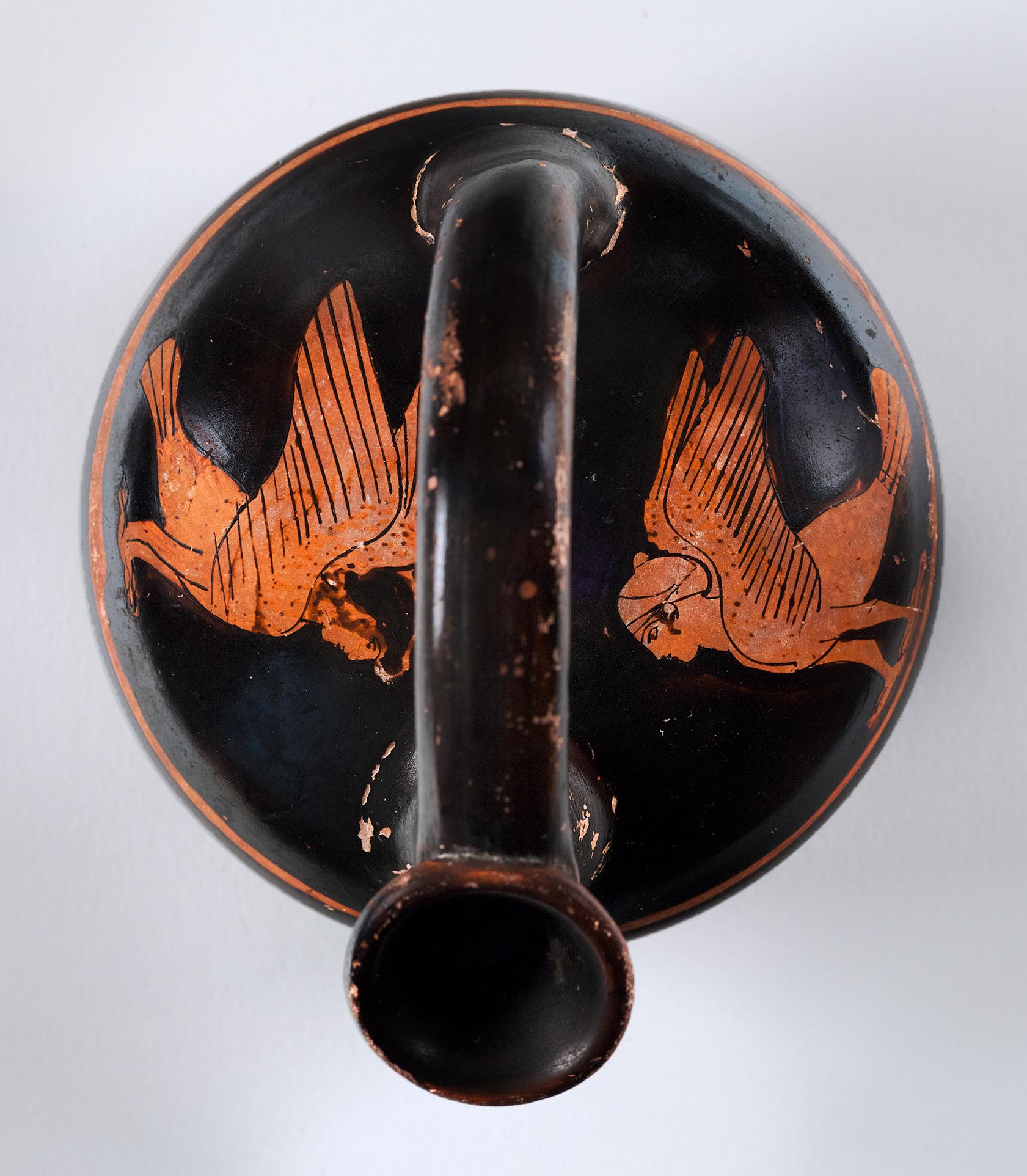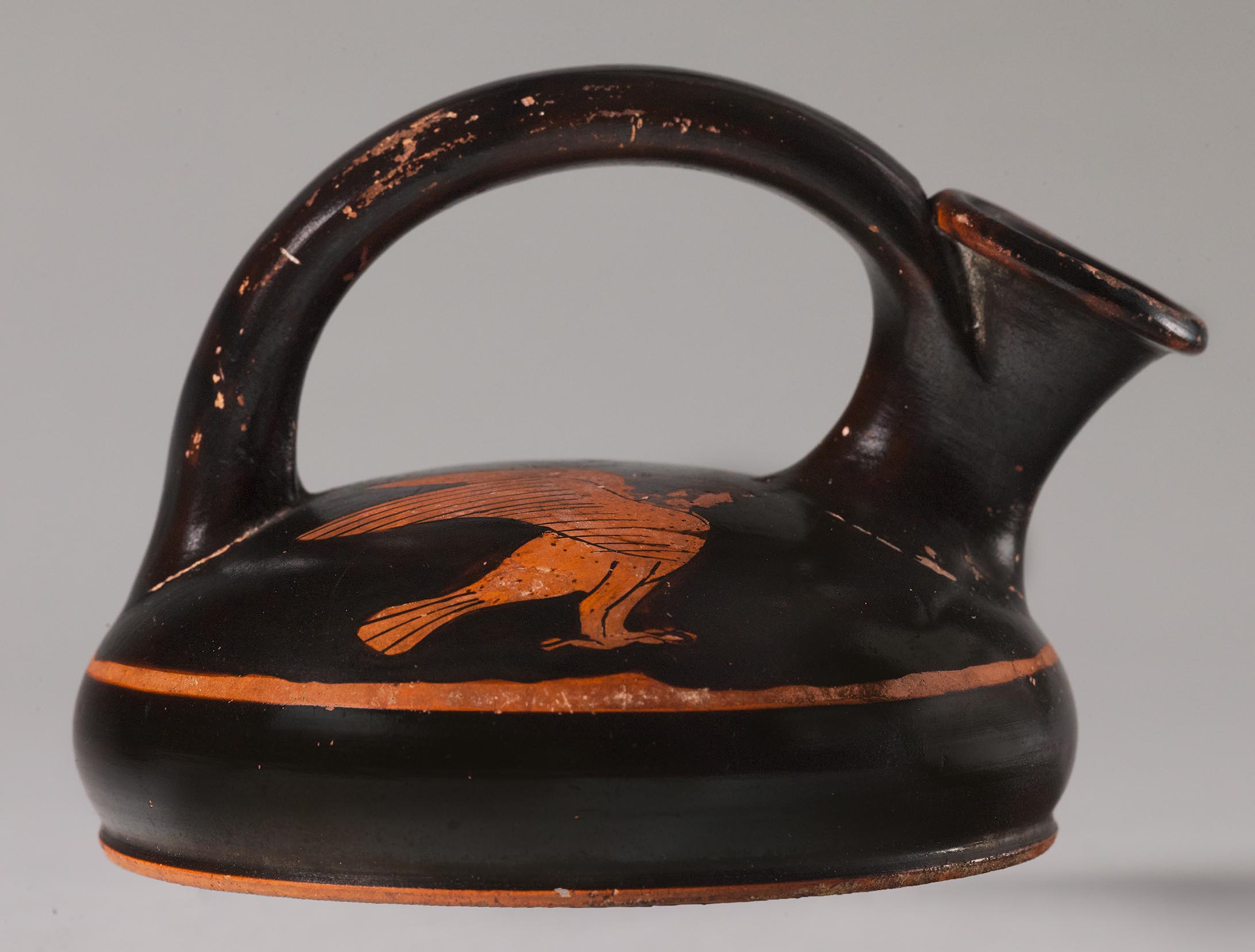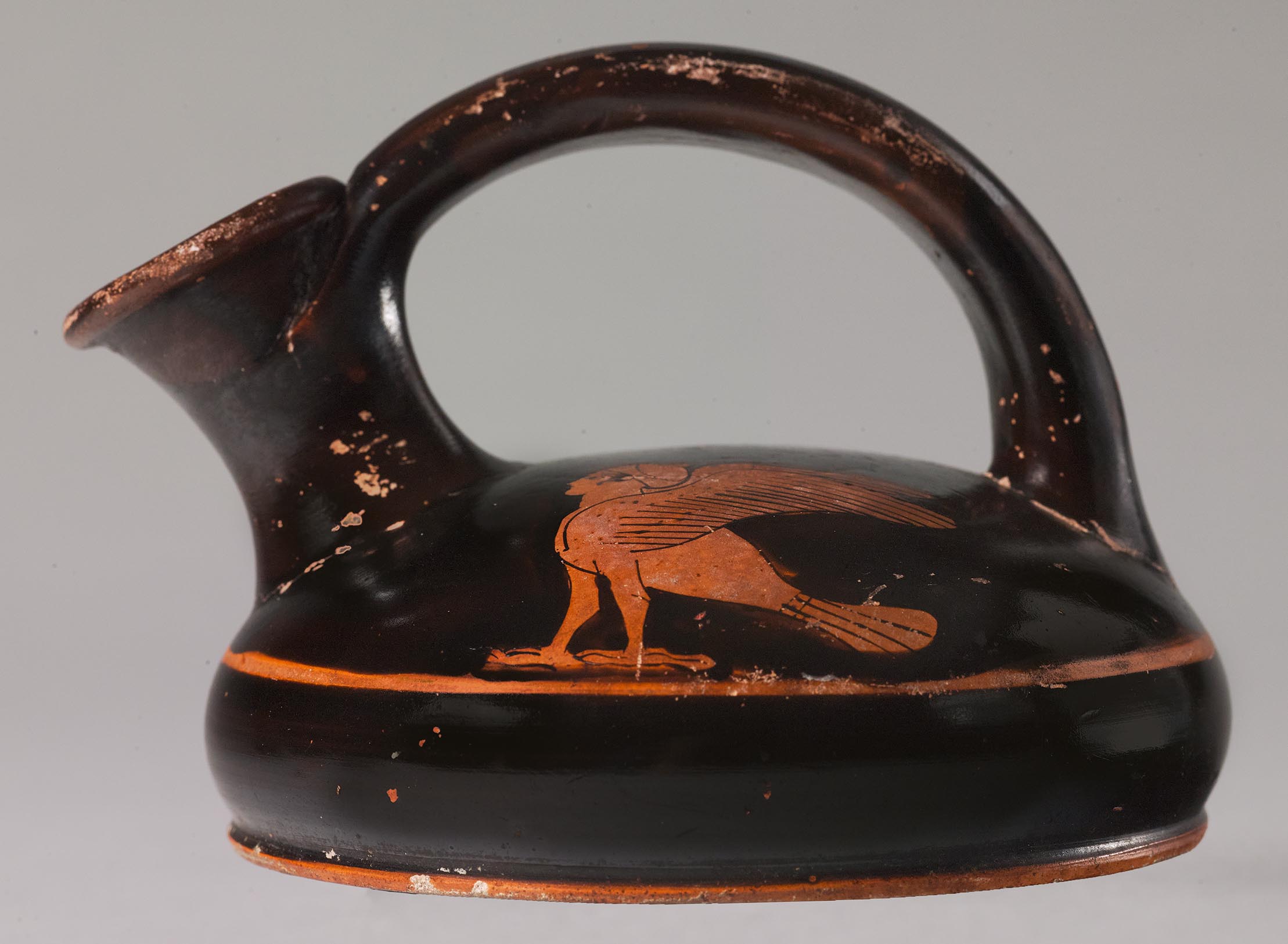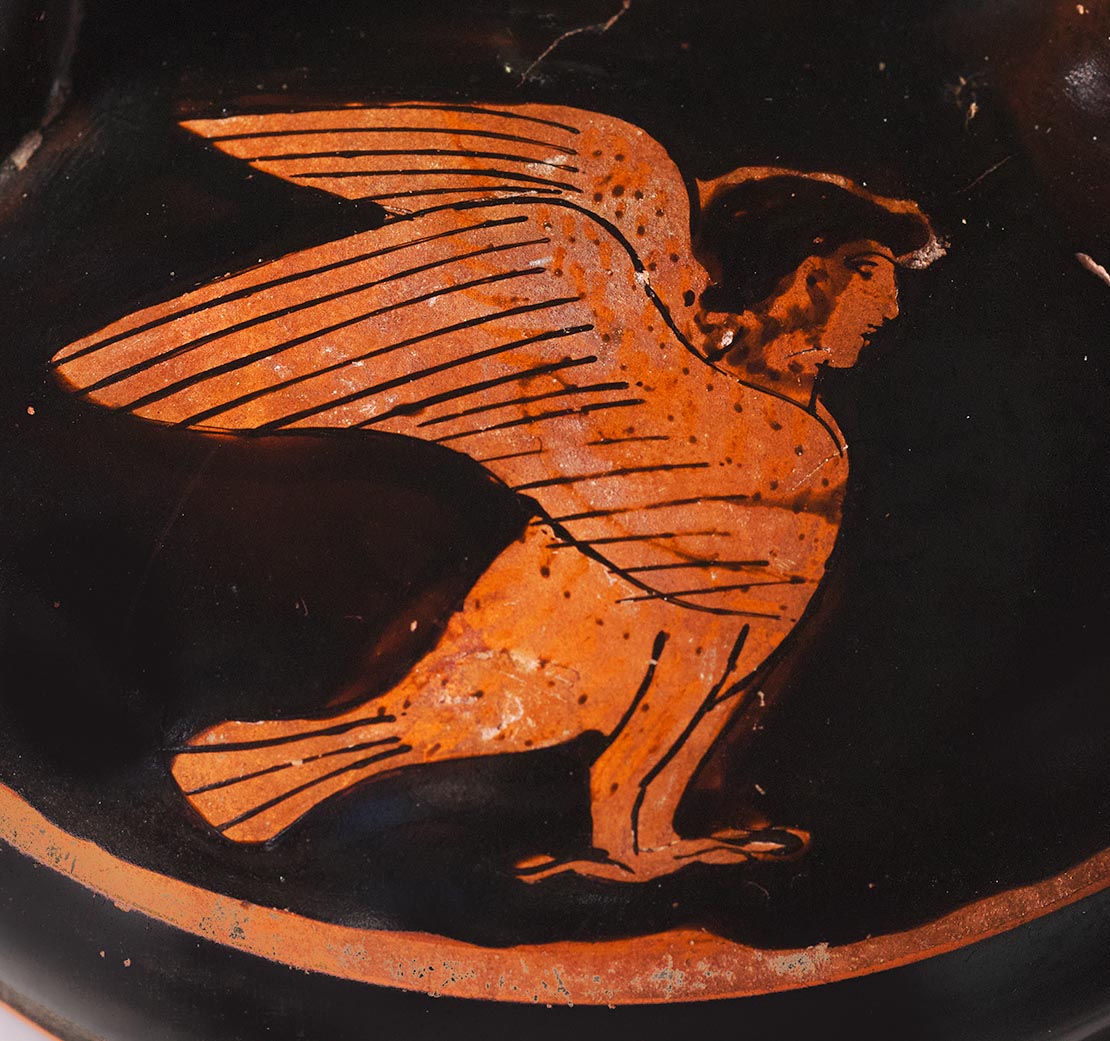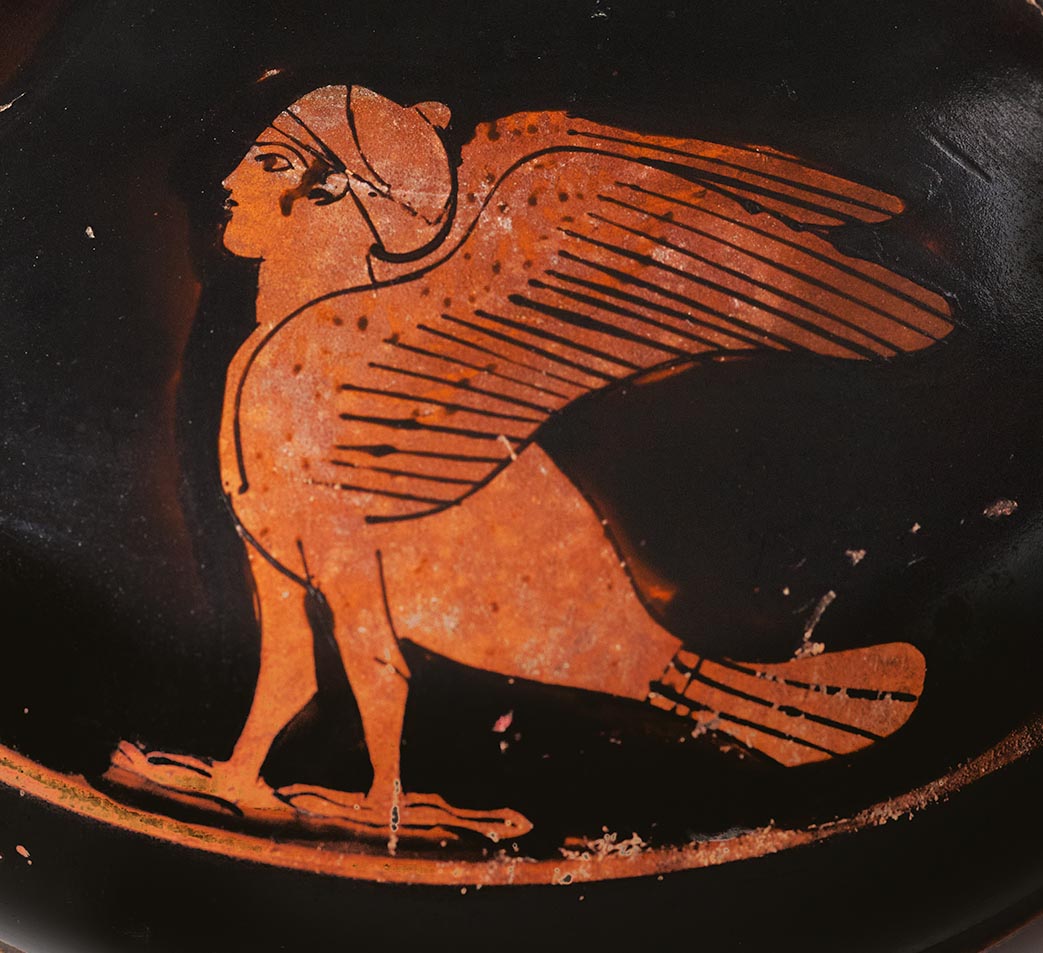Provenance
1927, sale, American Art Galleries, Alphonse Kann Collection (New York, NY) to Princeton University.
Shape and Ornament
Round, shallow body, black, with convex walls forming a low, domed upper surface. Narrow-necked, flaring spout rising obliquely from the shoulder. Interior of spout and neck black. Black strap handle, flattened oval in section, extending from back of spout to opposite shoulder. Continuous reserved stripe serves as a groundline for figural decoration. Slender torus ring base, with flat, reserved underside.
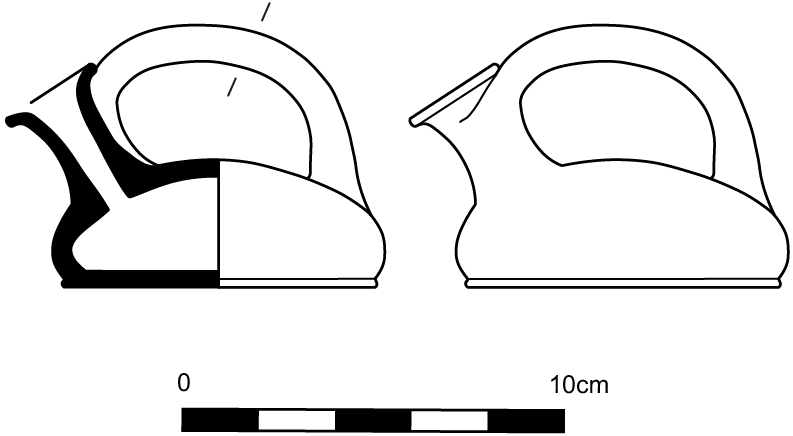
Subject
Two sirens. The two sirens, with women’s heads and birds’ bodies, occupy opposite sides of the handle, facing the spout. The feathers are drawn in great detail, with primary wing feathers and tail feathers executed with relief lines, and body feathers with dilute gloss. One siren wears her hair loose, with a lock falling on the side of her face, while the other wears her hair bound in a sakkos, with one tress escaping just in front of her ear. Both look straight ahead.
Attribution and Date
Unattributed. Circa 460–450 BCE.
Dimensions and Condition
h. 7.0 cm; w. 10.1 cm; diam. 8.8 cm; diam. of mouth 2.7 cm; diam. of foot 8.4 cm. Intact. Black gloss mottled in places, notably on the neck and by the tail of the siren to the right of the spout.
Technical Features
Preliminary sketch. Relief contours. Accessory color. Dilute gloss: meat of the wings.
Bibliography
American Art Assocation, The Alphonse Kann Collection: Sold by His Order; Part 1, Consisting of Egyptian, Greek, Roman, Persian, Moyan Age, and Renaissance Works of Art, auc. cat., January 6–8, 1927, New York, NY, no. 14; H. Hoffmann, Sexual and Asexual Pursuit: A Structuralist Approach to Greek Vase Painting (London, 1977), no. 124, pl. 10.1; E. Hofstetter, Sirenen im archaischen und klassischen Griechenland (Würzburg, 1990), 122, no. A176; D. M. Buitron, The Odyssey and Ancient Art: An Epic in Word and Image, exh. cat., Edith C. Blum Art Institute, Bard College (Annandale-on-Hudson, NY, 1992), 121 [illus.], 132, no. 43; Abbreviation: BAPDBeazley Archive Pottery Database. http://www.beazley.ox.ac.uk 6012.
Comparanda
For the shape, see Princeton y1955-3245 (Entry 40). The relatively high dome of y916, which on askoi generally tends to become lower over time, suggests a date in the first half of the fifth century, although the shallow askos shape does not appear to have a strict linear development. For instance, Princeton y1955-3245 has a significantly lower dome, but is dated earlier primarily due to the figural drawing. Toward the second half of the fifth century, the junction between the sides and tops of askoi becomes more marked, occasionally by a reserved groove, but on both of Princeton’s askoi, this junction remains smoothly continuous.
The composition is standard for askoi throughout the fifth century, with a single figure placed on either side of the handle. These figures may be arranged so as to suggest pursuit, or each may face the spout, as here. Hoffmann lists two other examples of heraldic sirens on red-figure askoi, neither of which is closely related to the figural drawing on the Princeton vase, the draftsmanship of which is more careful overall: Oxford 1925.71 (Abbreviation: ARV2J. D. Beazley. Attic Red-Figure Vase-Painters. 2nd ed. Oxford, 1963 776.2; Hoffmann, Pursuit, 13, no. 123, pl. 10.2; Abbreviation: BAPDBeazley Archive Pottery Database. http://www.beazley.ox.ac.uk 209573); Athens, Agora P 23263 (Abbreviation: ARV2J. D. Beazley. Attic Red-Figure Vase-Painters. 2nd ed. Oxford, 1963 661.85; Hoffmann, Pursuit, 13, no. 122; Abbreviation: BAPDBeazley Archive Pottery Database. http://www.beazley.ox.ac.uk 207744). In both cases the drawing of the face and feet is far less detailed. In his catalogue of red-figure askoi from Spina, Massei adds a fourth askos (presumably in Ferrara), dated to around 440 BCE, this time with two sirens on one side of the handle, and a large feline on the opposite side: L. Massei, Gli askoi a figure rosse nei corredi funerari delle necropoli di Spina (Milan, 1978), pl. 6.1.
Due to their status as ambiguous, liminal beings, the placement of sirens on askoi has been interpreted by Hoffmann (Pursuit, 6) as being associated with the rites of passage performed at burials: “these super-human bird-beast anomalies—part sexual temptresses, part harbingers of death—are prototypical denizens of the middle ground and mediate between earth and heaven.” For a similar notion, which stresses the sexual allure of sirens, see Buitron, Odyssey, 132. Sirens are often, although certainly not always, found in contexts associated with death, most clearly on grave monuments of the late fifth and fourth centuries. For sirens on grave monuments and in Greek art in general, see Hofstetter, Sirenen, 151–85, 303–410. For a critique of Hoffmann’s association of askoi with a funeral or ritual setting, see Princeton y1955-3245 (Entry 40).
